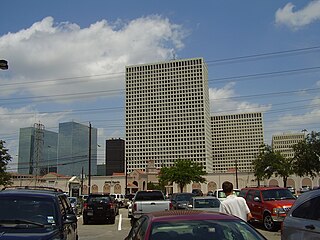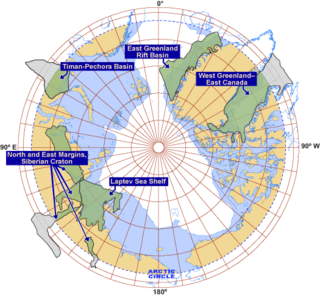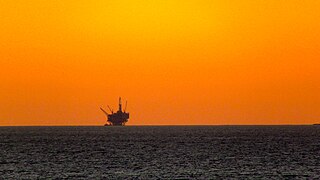
Transocean Ltd. is an American drilling company. It is the world's largest offshore drilling contractor based on revenue and is based in Vernier, Switzerland. The company has offices in 20 countries, including Canada, the United States, Norway, United Kingdom, India, Brazil, Singapore, Indonesia, and Malaysia.

The National Iranian Oil Company is a government-owned national oil and natural gas producer and distributor under the direction of the Ministry of Petroleum of Iran. NIOC was established in 1948 and restructured under The Consortium Agreement of 1954. NIOC ranks as the world's second largest oil company, after Saudi Arabia's state-owned Aramco.

The China National Petroleum Corporation (CNPC) is a major national oil and gas corporation of China and one of the largest integrated energy groups in the world. Its headquarters are in Dongcheng District, Beijing. CNPC was ranked fourth in 2022 Fortune Global 500, a global ranking of the largest corporations by revenue.

Eni S.p.A. is an Italian multinational energy company headquartered in Rome. One of the "supermajor" oil companies in the world, with a market capitalization of €48 billion, as of 31 December 2022. The Italian government owns a 30.33% golden share in the company, 4.37% held through the Ministry of Economy and Finance and 25.96% through the Cassa Depositi e Prestiti. The company is a component of the Euro Stoxx 50 stock market index.

Asaluyeh is a city in the Central District of Asaluyeh County, Bushehr province, Iran, and serves as capital of the county. Alternate spellings include: Assalouyeh, Asalouyeh, Asaloyeh, Asalooyeh, Asaluye, Assaluyeh, and Asalu. UNCTAD codes: IR YEH, IR PGU, and IR ASA.

The Tehran Stock Exchange (TSE) is Iran's largest stock exchange, which first opened in 1967. The TSE is based in Tehran. As of May 2023, 666 companies with a combined market capitalization of US$1.45 trillion were listed on TSE. TSE, which is a founding member of the Federation of Euro-Asian Stock Exchanges, has been one of the world's best performing stock exchanges in the years 2002 through 2013. TSE is an emerging or "frontier" market.
Oil India Limited (OIL) is a central public sector undertaking engaged in the business of exploration, development and production of crude oil and natural gas, transportation of crude oil and production of liquid petroleum gas. The central public sector undertaking is a Maharatna, with the Ministry of Petroleum and Natural Gas overseeing its operations. Headquartered in Duliajan, Assam, the company has its offices in Duliajan, Noida, Guwahati and Jodhpur.

The petroleum industry in Azerbaijan produces about 873,260 barrels (138,837 m3) of oil per day and 29 billion cubic meters of gas per year as of 2013. Azerbaijan is one of the birthplaces of the oil industry.

The Ministry of Petroleum (MOP) (Persian: وزارت نفت, romanized: Vezârat-e Naft) manages the oil industry, the producer of oil and petrochemical products. MoP is in charge of all issues pertaining to exploration, extraction, exploitation, distribution and exportation of crude oil and oil products. In addition, according to the "Imports and Exports Regulation Act", issuing import licenses for such products is also among the functions of the Ministry of Petroleum. The ministry has been placed under sanctions by the United States Department of State as of 2020.
The South Pars/North Dome field is a natural-gas condensate field located in the Persian Gulf. It is by far the world's largest natural gas field, with ownership of the field shared between Iran and Qatar. According to the International Energy Agency (IEA), the field holds an estimated 1,800 trillion cubic feet of in-situ natural gas and some 50 billion barrels of natural gas condensates. On the list of natural gas fields it has almost as much recoverable reserves as all the other fields combined. It has significant geostrategic influence.

Exploration for petroleum in the Arctic is expensive and challenging both technically and logistically. In the offshore, sea ice can be a major factor. There have been many discoveries of oil and gas in the several Arctic basins that have seen extensive exploration over past decades but distance from existing infrastructure has often deterred development. Development and production operations in the Arctic offshore as a result of exploration have been limited, with the exception of the Barents and Norwegian seas. In Alaska, exploration subsequent to the discovery of the Prudhoe Bay oilfield has focussed on the onshore and shallow coastal waters.

Offshore drilling is a mechanical process where a wellbore is drilled below the seabed. It is typically carried out in order to explore for and subsequently extract petroleum that lies in rock formations beneath the seabed. Most commonly, the term is used to describe drilling activities on the continental shelf, though the term can also be applied to drilling in lakes, inshore waters and inland seas.
Subsea technology involves fully submerged ocean equipment, operations, or applications, especially when some distance offshore, in deep ocean waters, or on the seabed. The term subsea is frequently used in connection with oceanography, marine or ocean engineering, ocean exploration, remotely operated vehicle (ROVs) autonomous underwater vehicles (AUVs), submarine communications or power cables, seafloor mineral mining, oil and gas, and offshore wind power.
Saipem S.p.A. is an Italian multinational oilfield services company and one of the largest in the world. Until 2016 it was a subsidiary of Italian oil and gas supermajor Eni, which retains approximately 30% of Saipem's shares.

The petroleum industry of Ghana is regulated by the state-owned Ghana National Petroleum Corporation (GNPC) and administered by the state-owned Ghana Oil Company (GOIL).
The National Iranian Tanker Company is a subsidiary of the National Iranian Oil Company, which was privatized in 2009. As of 2011, NITC was owned by funds managing pensions for 5 million Iranians. It is the biggest tanker company in the Middle East. The company transports Iranian crude oil to export markets and also engages in cross-trading of crude oil cargoes for some 150 oil majors worldwide, including Royal Dutch Shell, TotalEnergies, Saudi Aramco and state-run producers in Kuwait and Abu Dhabi. NITC has a capacity of 11 million tons per year.

Crescent Petroleum is the first and largest private upstream oil and gas company in the Middle East. Founded in 1971, Crescent Petroleum is headquartered in the Emirate of Sharjah, United Arab Emirates (UAE), with current operations in both the UAE and the Kurdistan Region of Iraq (KRI). As of 2023, Crescent Petroleum and the Iraqi Ministry of Oil have signed three twenty-year contracts as the company focus it efforts in aiding the redevelopment of Iraq.
The Iran Marine Industrial Company, also known as SADRA, was founded in 1968 as a small ship repair yard in Bushehr. Since then, SADRA has established itself as the leading shipbuilding and ship repairing company in Iran. SADRA is also active in offshore oil & gas development. SADRA specializes in building ships, docks, and floating oil rigs. Sadra Group is a sister company of Iran's state-owned Iran Shipbuilding and Offshores Industries Complex Co. (ISOICO). As of April 2009, the IRGC-controlled construction conglomerate, Khatam al-Anbia owns a controlling stake in SADRA.
New Exploration Licensing Policy (NELP) was conceptualised by the Government of India, during 1997-98 to provide an equal platform to both Public and Private sector companies in exploration and production of hydrocarbons with Directorate General of Hydrocarbons (DGH) as a nodal agency for its implementation. It was introduced to boost the production of oil and natural gas and providing level playing field for both public and private players.

Dana Energy is a private oil and gas company headquartered in Tehran, Iran. It is an exploration and production (E&P) and oilfield services company operating in Middle East and Asia. Formed in 2000, they were initially an oilfield services company and ventured into field development in 2008. By the addition of petroleum products trading to its portfolio in 2013, Dana Energy extended their business into the midstream sector, however due to sanctions imposed on Iran, their trading division came to a halt.













